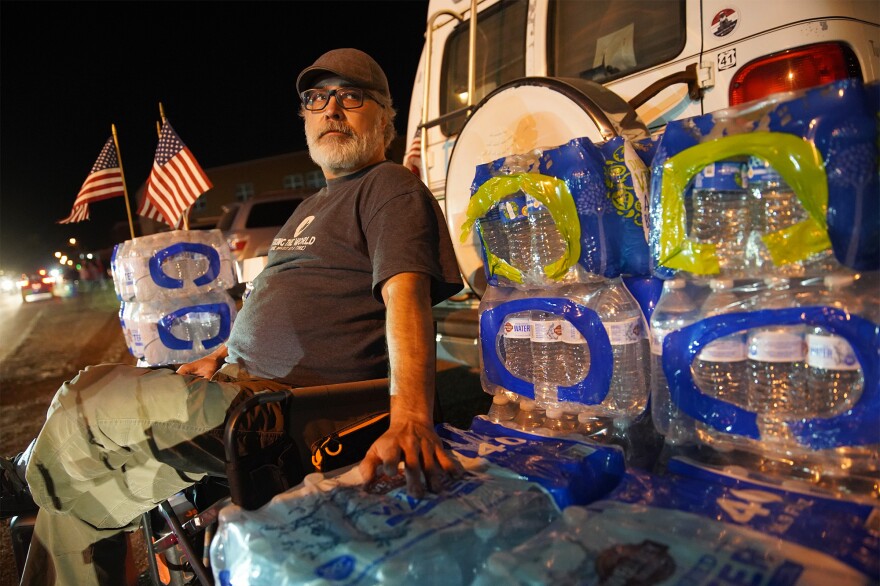Updated February 16, 2023 at 1:04 PM ET
The derailment of a train carrying hazardous materials near a town in Ohio earlier this month has prompted environmental concerns and chemical fears for residents — even as state officials work to reassure them.
"From the very start of this, we have taken every step possible to assure that people's safety was first and foremost," Dr. Bruce Vanderhoff, the director of the Ohio Department of Health, said at a Tuesday press conference.
And as authorities work to assess the damage and investigate the derailment, more information has emerged this week about the chemicals in the rail cars, a variety of contaminants and carcinogens. Some of the chemicals — five rail cars' worth of vinyl chloride — was intentionally burned off in a "controlled explosion" last week, which prompted a temporary evacuation of the area.
Some residents have reported headaches and rashes in the days since the derailment. And many have expressed frustration at what they say is a lack of answers from the railroad company and public officials.

On Wednesday night, those worries bubbled over in a raucous town hall meeting. "I feel the entire city, and I feel our leaders, everybody, is letting us down," homeowner Aaron Bragg told Ideastream Public Media.
Here's what to know about the derailment and chemicals involved.
A train carrying hazardous substances derailed earlier this month in eastern Ohio, likely due to mechanical issues
On Feb. 3, just before 9 p.m. ET, a Norfolk Southern train derailed near East Palestine, Ohio, a town of about 4,800 people near the border with Pennsylvania. Nobody was hurt in the accident, officials say.
Most of the train's 150 rail cars were carrying cargo that was not hazardous, officials say, such as cement, steel and frozen vegetables, according a manifest of the derailed cars provided to the Environmental Protection Agency.
But 20 cars contained hazardous materials, according to an update this week from the National Transportation Safety Board, which is investigating the derailment.
About three dozen cars derailed overall, 11 of which were carrying hazardous material, investigators said.
The NTSB's investigation is not yet complete, but early signs suggest that a faulty wheel bearing on one rail car may have caused the derailment, the board said.
Surveillance video from a home near the crash site recorded "what appears to be a wheel bearing in the final stage of overheat failure moments before the derailment," investigators said this week.
The NTSB says it expects to release a preliminary report in about two weeks.
Several cars were carrying vinyl chloride, a cancer-causing substance. Other cars held other hazardous substances
Five of the derailed cars were carrying vinyl chloride, a manmade substance that is a key ingredient in PVC, the hard plastic resin used widely in construction and health care.
At room temperature, vinyl chloride is a sweet-smelling colorless gas. It is typically transported in the form of a compressed liquid.
Inhalation of vinyl chloride can cause respiratory symptoms like shortness of breath, along with neurological symptoms like headaches and dizziness. Chronic exposure to high levels of vinyl chloride has been associated with liver damage and cancer, according to the CDC.
This week, the EPA released a partial Norfolk Southern manifest that detailed other hazardous chemicals on the train, which included ethylene glycol monobutyl ether, ethylhexyl acrylate and isobutylene. All can cause irritation or neurological symptoms like dizziness and headaches.
One tank car lost its entire load of butyl acrylate, a clear liquid used to make paint, adhesives and caulk. The New Jersey Department of Health warns that exposure to butyl acrylate can cause headache, dizziness, nausea and irritation to the nose, throat and lungs.
In order to avoid a catastrophic explosion, officials evacuated residents and intentionally burned off some of the chemicals
Over the weekend after the derailment, firefighters worked to contain the blaze caused by the derailment.
Authorities eventually grew concerned about rising temperatures inside a single rail car, which they worried could cause a catastrophic explosion sending shrapnel up to a mile away.
"The risk of the car exploding was described to me as high," Gov. Mike DeWine said at a press conference Tuesday.
Ultimately, officials decided to pursue a "controlled release" of the volatile vinyl chloride. Because burning vinyl chloride can cause the production of other toxic chemicals, including hydrogen chloride and phosgene, officials ordered the evacuation of a one-by-two-mile area around East Palestine, on both sides of the state line.
On Feb. 6, crews released the vinyl chloride from the derailed cars into a trench, where they burned it off in a "controlled explosion," causing a dramatic plume of black smoke.
The fire was finally extinguished on Feb. 8, after which the evacuation order was lifted. Officials said air quality was measured and deemed safe before allowing residents to return home.

The EPA says the air in East Palestine is safe
The EPA has had personnel on-site since the hours immediately after the derailment.
Since the fire was put out, air monitoring conducted by the EPA has not detected "any levels of health concern" in the area that would be connected to the train derailment, the agency said this week.
In addition to monitoring the air outdoors, the agency has screened indoor air at nearly 500 homes. No detection of vinyl chloride or hydrogen chloride have been identified, the EPA said.
"The good news is, by the time we were at the decision point for potentially bringing people who had evacuated back into an impacted area, we had on hand air testing that told us that the air really looked pretty much like it did before this event ever happened," said Vanderhoff of the Ohio Department of Health.
Officials say the municipal water in East Palestine is safe to drink, but those with private wells should use bottled water until further testing can be completed
Water samples taken last week show "very low levels" of two contaminants -- butyl acrylate and ethyl hexyl acrylate — from the derailment in a creek that runs through East Palestine, the Ohio Environmental Protection Agency reported. Additionally, no vinyl chloride was detected in waterways, officials said.
This week, officials announced that tests on municipal water sources in the East Palestine area indicated that the water was safe to drink.

State and local officials have urged people with private wells to have their water tested. This week, the EPA said samples had been collected from 28 wells so far.
The release of chemicals caused the deaths of 3,500 fish in the days following the derailment, the Ohio Department of Natural Resources estimated. Department officials said there is no evidence of an increase in fish deaths since those early days, and that there are no signs of harm to other types of animals.
A plume of contaminants released in the initial derailment did reach the Ohio River, Ohio EPA director Anne Vogel said Tuesday. But a variety of containment measures had been put in place to ensure the safety of drinking water.
"The Ohio River is very large, and it's a water body able to dilute the pollutants very quickly," Vogel said. "We're pretty confident that these low levels are not getting passed onto the customers."
Some residents of East Palestine say they still feel unsafe
After the crash, some residents have complained of strong smells, headaches and nausea. Though many have returned home since the evacuation order was lifted, several told NPR that they feel nervous about the quality of their air and drinking water.
"It almost seems back to normal, except we all have this looming hazardous cloud, not knowing what it's going to do to our future, hanging over our heads," said Dianna Elzer, whose home is about 600 yards from the site.
The "cloud" is metaphorical, she clarifies – the weather has been windy and sunny lately.
But the situation has caused her to lose sleep, because she's constantly trying to find more information about the derailment and the chemicals involved. She shares that information on a neighborhood Facebook group.
She said she has seen the press conferences with EPA officials and the governor encouraging residents to return home, but still has doubts about her long-term safety.
"That's not real reassuring that they're just going to say, 'Oh, everything's good,' because we aren't going to know the true ramifications of what the impact on the environment is for a while," she said.
Maggie Guglielmo, the owner of a small wristband manufacturing company, said her business has had a strong odor since the derailment, though it has lessened over time.
"I wear an N95 mask when I go in, but I can still smell the stuff," she said. "I also wear goggles, but it's still irritating my eyes."
This week, an EPA testing crew found the air quality inside the building to be safe, she said. But she was awaiting the results of a private air assessment she had paid for out of pocket.
On Wednesday night, hundreds of East Palestine residents crowded into a high school gym to press state and local officials for answers about air and water testing and the risks of long-term exposure.
"Why are people getting sick if there's nothing in the air or in the water?" one resident shouted to thunderous applause.
The meeting was originally meant to include representatives from Norfolk Southern. But a few hours before the meeting was set to begin, the railroad pulled out, saying in a statement that it had become concerned about a "growing physical threat to employees and members of the community."
Ohio's governor is urging Congress to change rules around hazardous cargo notification requirements
Because most of the rail cars were carrying non-hazardous materials, Norfolk Southern was not subject to laws that would have compelled them to notify Ohio officials of the train's contents. On Tuesday, DeWine urged Congress to consider changes to hazardous cargo notification requirements.
"Frankly, if this is true – and I'm told it's true – this is absurd," DeWine said. "We should know when we have trains carrying hazardous material that are going through the state of Ohio."
Additional reporting by Ideastream Public Media's Abigail Bottar in East Palestine and NPR's Alejandra Marquez Janse in Washington. contributed to this story
Copyright 2023 NPR. To see more, visit https://www.npr.org.




